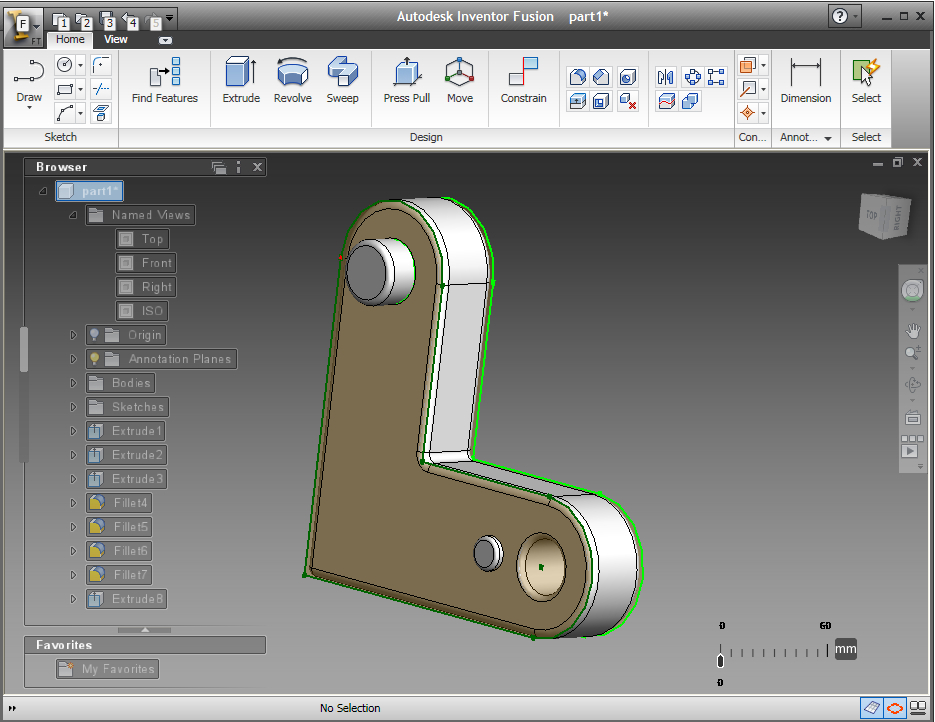Latest News
June 24, 2009

A little more than two weeks after Siemens PLM Software unleashed Solid Edge with Synchronous Technology 2, the second incarnation of its mid-range direct modeler, Autodesk delivered its own version as a technology preview. This week marks the premiere of Autodesk Inventor Fusion—not as a series of video clips or screenshots but an executable code, ready for test drive. (The code is available from Autodesk Labs.)
In February, when Autodesk gave us a peek of Inventor Fusion, it was presented to us as a technology that would bridge parametric and direct modelings. At the moment, the bridge is still under construction.
Kevin Schneider, Autodesk’s technology evangelist for manufacturing solutions, said, “Later this year, we’ll be previewing an Inventor Fusion feature where a user will be able to make an explicit edit [direct edit], but when that’s completed, they can choose to continue to design in explicit [mode] or return to the parametric or history-based environment. When they do [the latter], they’ll be allowed to convert their explicit feature into a parametric feature.”
In the announcement, Autodesk reveals, “The June 2009 preview is the first step toward Autodesk’s goal of providing seamless bidirectional parametric and direct workflows to users by allowing them to adopt the modeling approach that best fits their needs in a single application. The company is planning a second technology preview this fall that will enable users to perform direct modeling for fast changes and then see their changes updated in the model’s parametric feature history, maintaining crucial design intent.”
The First Incarnation
The first release of Inventor Fusion exhibits a direct modeler’s characteristics, with the ease of use and push-pull modeling we’ve come to expect from such programs. Autodesk gave me access to the software with limited documentation. That was intentional, Schneider later revealed. The way an unassisted user explores the software can give him and his development team clues about how intuitive the interface is.
My editorial career has exposed me to various 3D software products and how they work, but I am by no means a CAD expert. (In fact, I don’t mind admitting that I feel more comfortable in SketchUp than in a CAD program.) My limited CAD experience notwithstanding, I found Inventor Fusion’s commands quite easy to figure out: I pull on a face to add height to a profile; I select a feature and push it along an axis to move it; I move faces to adjust the volume of my 3D model; and so on.
I normally think of 2D sketching as precision drawing, but the flexibility of Inventor Fusion’s sketch mode makes me rethink. Because I can push and pull on lines, arcs, and intersections to adjust their length, height, and angle, I felt I was in an exploratory environment.
I also imported a STEP file, a Jergens bracket found on 3D Content Central, to see how Inventor Fusion handles imported data. I was able to use the Find Features command to let the software automatically scan the imported part and build a bill of features (extrusions, faces, holes, bodies, and so on), cataloged under the Browser. Since the Browser is located roughly where you’re accustomed to seeing a feature tree, you might be tempted (like I was) to select a face or a boss from it when you want to modify it. The recommended approach, Schneider told me, is to use the Move Face command or to select the boss in question right in the model and drag it to a new location.
In modifying imported geometry, Inventor Fusion sometimes produced odd results (watch the video below). Schneider is confident that, as the code matures, Inventor Fusion will get better at resolving geometric conflicts that arise from such edits; consequently, the oddities I encountered with the present code will disappear.
Despite some awkward behaviors, Inventor Fusion struck me as a promising start, a harbinger of the direct-editing capabilities that will eventually find their way into commercial versions of Autodesk Inventor.
For more, read the upcoming feature “Autodesk Inventor Fusion Comes Out of Hiding” in the next edition of Virtual Desktop MCAD News (June 25) or watch the video below:
Subscribe to our FREE magazine, FREE email newsletters or both!
Latest News
About the Author
Kenneth Wong is Digital Engineering’s resident blogger and senior editor. Email him at [email protected] or share your thoughts on this article at digitaleng.news/facebook.
Follow DERelated Topics






